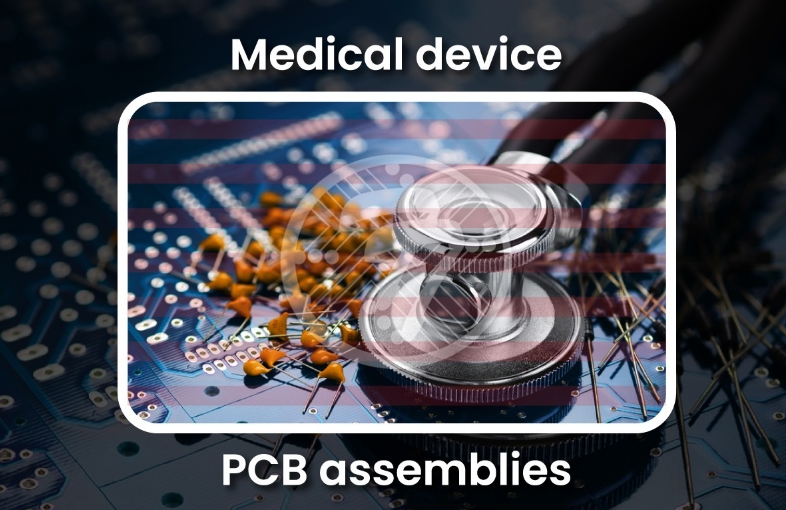
All kinds of digital tools in healthcare, from smartwatches that check your health status to important MRI machines, use Printed Circuit Boards (PCBs).The multilayer printed circuit boards, which consist of multiple copper layers, have surfaced as a prime choice due to their functionality, durability, and reliability. However, what is the multilayer PCB manufacturing process, especially for those used in medical devices? Let's delve into this process, where layers can make the circuit more dynamic and high-performing.

Unlike single layer PCBs and double sided PCBs, Multilayer PCBs boast an odd number of layers, bound by dielectric materials. These PCBs, preferred in high-speed circuitry due to their high resistance to interference, can endure high temperatures, thus adding to the long list of advantages of multilayer PCBs.
The compact size, improved functionality, and high reliability of multilayer PCBs cater to the application requirements of many medical devices. Compared to single-sided variants, these layer PCBs allow complex circuits and high signal integrity, proving their optimal fit for the medical industry.
Creating a multilayer PCB involves a series of intricate steps, from PCB designing to the manufacturing process.
The production process commences with a detailed digital blueprint outlining all the circuit layers and connections. The design caters to all necessary requirements, including high-density and complex circuits.
The selection of suitable materials is imperative in the manufacturing process. Usually, FR-4, a type of glass fiber epoxy laminate, serves as the substrate.
Initially, the substrate is coated with copper to form the inner layer. This layer is then etched away, leaving the desired copper traces.
Copper layers are nestled between dielectric material, and heat and pressure are applied for the layers to fuse into a solid board.
Post-lamination, holes are drilled to accommodate the assembly components. The holes are then coated or plated with copper to establish an electrical connection between the layers.
The outer layer is coated with a photosensitive film developing into a pattern. Additional copper is then plated onto this layer.
The fabrication process concludes with the application of a solder mask to protect the PCB from oxidation and prevent potential short circuits. Silkscreen then adds identifying marks and symbols.
Multilayer Printed Circuit Boards, often referred to as PCBs, have become a fundamental aspect in a broad range of medical equipment. Their inalienable role can be observed in a multitude of healthcare gadgets, running the gamut from defibrillators to pacemakers, and even stretching as far as advanced medical imaging systems.
One of the key reasons for their pervasive deployment is their impressive dependability. In the highly sensitive field of healthcare, where the precision of medical devices can often be a matter of life or death, these multi-faceted circuit boards excel, bringing about a high degree of dependable performance.
Additionally, another compelling attribute of these multilayer PCBs is their compact form factor. In a sector where the successful miniaturization of equipment is a critical engineering challenge, these small-scale PCBs shine, integrating a complex network of circuits into a compressed, slender structure.
In conclusion, it's the synthesis of both the unswerving reliability and the compact nature of these multilayer PCBs that render them a vital component in an expansive range of medical devices, contributing significantly to their functionality and efficiency.
The manufacturing process of multilayer Printed Circuit Boards (PCBs) necessitates an unwavering commitment to maintaining a high standard of cleanliness, dependability, and uniformity. These standards must not be treated as optional but need to be stringently upheld in order to ensure the optimal functioning and durability of the product.
A consistent environment of sterility is of utmost importance during the production lines. Any form of contamination could lead to catastrophic issues with the functionality of the PCBs, subsequently undermining the reputation of the manufacturer and endangering the end user's safety.
Reliability, in the realm of multilayer PCBs, is synonymous with quality assurance. Every single board produced must satisfy the meticulous quality control measures that are in place. There is no room for boards that perform unpredictably or fail prematurely. Any compromise on this front could lead to failures, possibly putting a heavy cost burden on the customer.
Consistency, too, is an imperative watchword in PCB production. Uniformity in the manufacturing procedure, as well as in the output, is crucial to maintaining a trustful relationship with the clientele. A constant quality of production promotes confidence in the product, fostering a stronger business relationship with the consumers.
The precise electrical connections form the lifeline of the PCBs, essentially breathing life into them. It means that intricately designed connections with minute attention to detail are utterly important. Each thread of connection, each wire and each pin, plays a pivotal part in the overall assembly of the multilayer PCBs.
In addition to the above, a clear and well-laid out delineation of power planes and ground planes is an absolute necessity. It is these aspects that directly influence health-related functionalities of the finished product. Without well-structured power and grounding planes, a PCB can fail to perform accurately, leading to discrepancies in health equipment where these boards often feature prominently. This might result in grave consequences, potentially causing critical errors in health diagnostic or monitoring systems.
In summary, the world of multilayer PCB production is clearly an intricate one. It runs on the imperatives of maintaining high standards in sterility, reliability, and consistency, all working in alignment with the design of precise electrical connections and well-structured power and ground planes. It is this complex interplay that ensures the PCBs' stringent health-related functionalities are met and sustained effectively.
Producıng a multilayer PCB for medical appliances involves a complex process with detailed planning, quality material selection, and precise execution. However, the result justifies this complexity - a seemingly minor yet potent component playing a significant role in the technological revolution in healthcare.